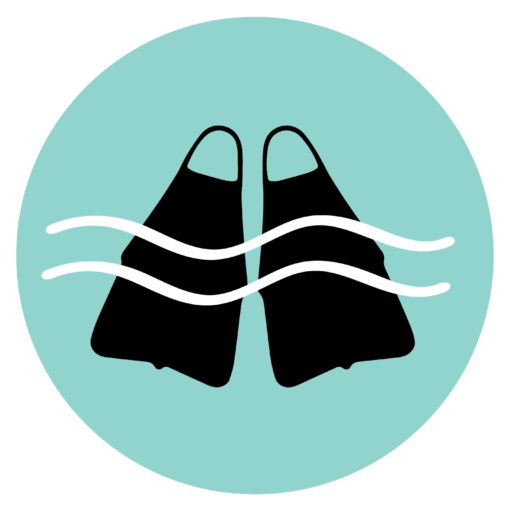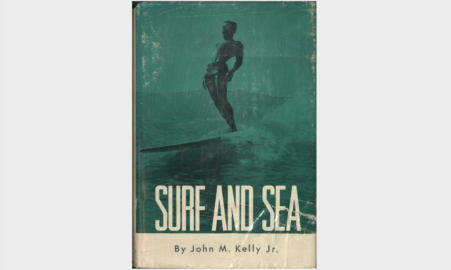Surf and Sea is a rare book about surfing published in 1965 by legendary waterman John M. Kelly Jr. Surf historian Matt Warshaw calls Surf and Sea, “the most intelligent, well-crafted book even written on surfing.”
Now a collector’s item, the book includes a chapter of particular interest to me titled “Body, Mat and Belly Board Surfing.” Luckily, I was able to access scans of this chapter via San Diego State University’s Special Collections Library.

The chapter is full of insightful bodysurfing knowledge written at a time when bodysurfing was just starting to gain popularity. Interestingly, many surf movies and books from the 1960s include segments about bodysurfing.
Surf and Sea was written by John Kelly Jr., a skilled bodysurfer and all-around waterman from Hawaii. Many board surfers from Kelly’s era (1950s and 60s) were good bodysurfers and swimmers because they didn’t have leashes. Other great bodysurfers from this era include Buffalo Keaulana, Pete Haworth, and Reed Waters. According to surf filmmaker Bud Browne, John Kelly was the best bodysurfer he had ever encountered.

Nuggets of Bodysurfing Wisdom from Surf and Sea
There’s a saying that goes: “If you want a new idea, read an old book.” When it comes to bodysurfing insight, John Kelly’s Surf and Sea provides just that. Here are some of my favorite nuggets of wisdom from the book:
History of bodysurfing: “Tales of bodysurfing and belly board (paipo) surfing abound in the ancient legends of Oceania. The sport attracted young and old. Its lore features romance, contests and the names of famous chiefs and it is probably an older sport than board surfing.”
Swimming as prerequisite skill: “It should be obvious that knowing how to swim well is a prerequisite for any sport in the surf. Quite often, however, the young or inexperienced think that they can handle waves in water that is not over their heads. A number of these unfortunate people drown every year. So here again, we’d like to remind one and all that learning how to swim well and acquiring endurance are the first rules for safe enjoyment of the ocean.”
How to catch waves: “In deeper water, the best way to catch a wave, bodysurfing, is to wait until the very top crest of the wave (the steepest part) is not more than a foot from your elbow and nearly ready to break. At that moment you give one good strong thrust with your fins and a single powerful arm stroke and you’re on your way. For an instant you have to lower your head and arch your shoulders to help get the forward part of your body moving down the forward slope of the wave. The Hawaiian position for the arms is at the side, palms up or down to increase the planing surface; Australians and some Californians prefer hands out ahead.”
Take-off technique: “A clean take-off technique is done without arm-stroking out of water. The wave approaches, nearly ready to break. With one strong scissor-kick thrust of the fins you propel yourself into a slide on the steep slope of the wave and you’re off in the curl. This take-off marks the style of a good bodysurfer.”
Learning to slide: “After you have mastered riding the wave straight-off, then your real pleasure begins—learning to slide. As with board surfing, slide consists of turning in the direction away from the soup (accomplished by leaning the body to the side) and sliding smoothly along the glassy edge of the wave.”
Advanced body positioning: “A refinement for the expert consists of the slide-ride position. When the wave wall is vertical or nearly so, he makes a sudden change from the conventional chest-riding position by lifting the right shoulder and arm (on a right slide) out of the water, throwing the right forearm and hand diagonally across in front of his chest, turning the hand palm down in the new position in front of the body. The result is that the right shoulder and upper arm no longer drag in the water. The right forearm and hand, acting like a fin, help support a high-riding position on the steep wall. The speed is greatly increased enabling the bodysurfer to ride in this manner on his side, back to the wall, in the tunnel with the crest hanging over in front of him. This is probably the speediest hot dog form to be seen in bodysurfing, but it can only be done when the wave is very steep.”
Bodysurfing big waves: “Let us suppose you are determined to bodysurf waves over ten feet high. You need top swimming ability, good conditioning, advanced knowledge of channel currents and surf conditions in general as well as of local conditions, and, of course, swim fins. In the old days, it was rare occasion that a barefoot bodysurfer could get up enough speed to slide out in the clear edge and avoid going over the falls with the crest of a big wave. But today, with the added power of swim fins for the take-off, it is possible to ride the heavies though it is certainly not recommended for the inexperienced. You have to have keen judgement of the wave and be precisely in the right spot for the take-off, near enough to the steep crest to catch the wave and close enough to the edge to slide clear of the powerful and threatening falls. Riding the soup in the heavies is out of the question.”
Good clean fun: “Bodysurfing, mat surfing, and belly board surfing are safer, easier, and more fun when the rider uses swim fins. All three are among the most healthful of water sports. At their simplest, you need only baggies or a bikini, some waves and a little free time to have just loads of good clean fun.”


